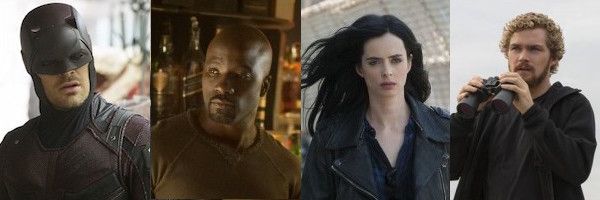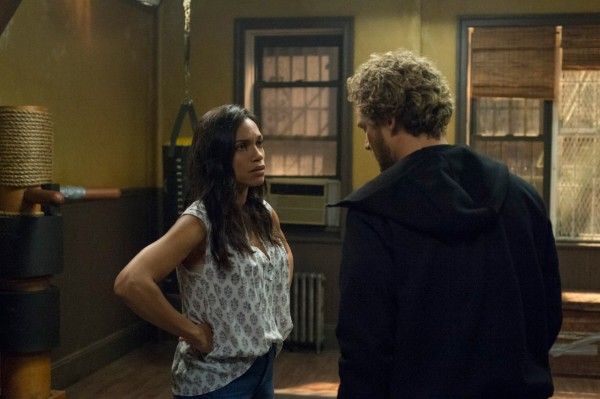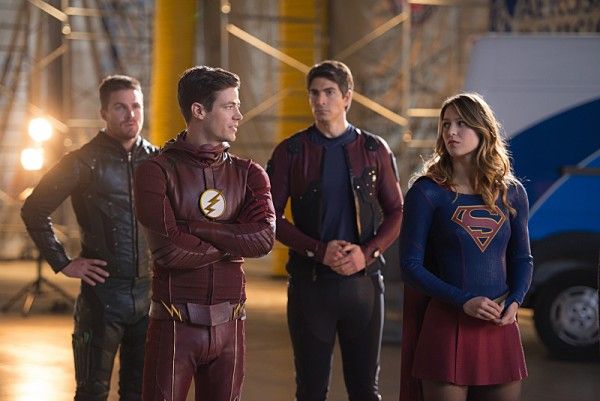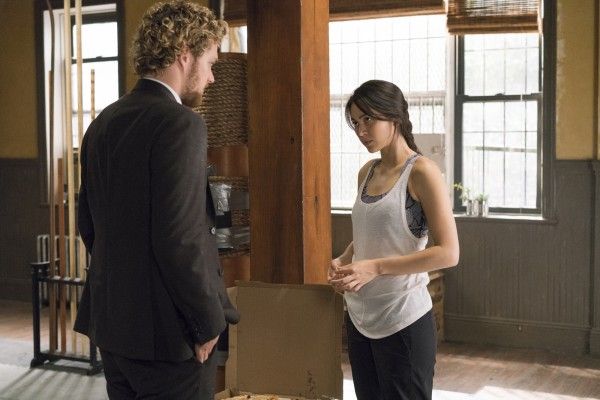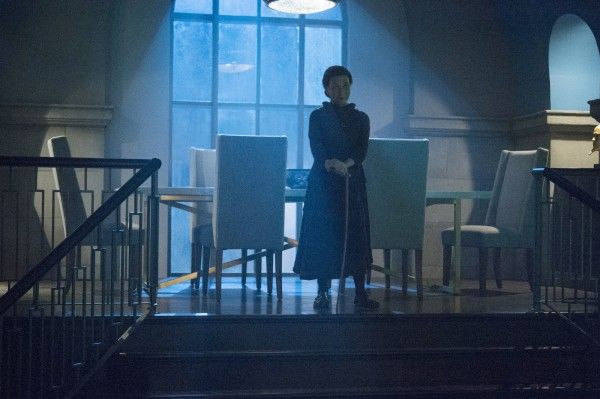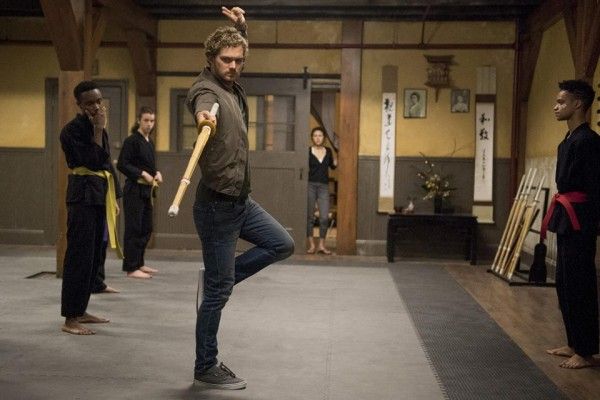When it comes to its Netflix series, Marvel has made the curious decision to not interconnect its world until the official team-up of The Defenders. In the movie universe, films like Iron Man, Thor, and Captain America each introduced us to a comic hero that wasn’t particularly well known, giving each a distinct origin story that enriched the eventual Avengers team-up. You didn’t have to see all of the proceeding films to enjoy The Avengers, but there was a lot of payoff if you had. Same thing for the TV shows, right? But a film of that kind is on average about 120 minutes long. Marvel’s Netflix series are 13 episodes each. That’s 13 hours exploring the origins of unfamiliar characters to the exclusion of the ones we have already met. We’ve always known Daredevil, Jessica Jones, Luke Cage and Iron Fist would would be part of a connected universe, so why wait?
With each passing season of the Marvel Netflix shows, that question becomes more urgent. None of these series have yet proved that they have the story to fill 13 episodes (with the possible exception of Jessica Jones, although it would have been potentially perfect at 10). When I watched the first 4 episodes of Luke Cage’s season, I loved its deliberate pacing to start, but thought things would end up moving faster. Instead, it stagnated with a pace I would now generously call glacial. Iron Fist is yet another example — its first few episodes are almost comically drawn out; the first two should have played out over an hour tops. The connections to the other series exist, but they are superficial; Claire Temple shows up in each series, but by the time we see her in Iron Fist she’s shoe-horned into the story, and also doesn’t bother mentioning the names or circumstances of any of the other supers she’s met to one another. Jeri Hogarth connects Jessica Jones and Iron Fist, but only by her presence, not by any meaningful storyline. (Gao may be an exception, but it's not like she's chatting about Matt Murdock either).
What’s frustrating is that the real connecting factor among these heroes in the comics is Luke Cage. He’s close friends with Danny Rand in their Heroes fore Hire business, and romantically linked to Jessica Jones (and not just for a half-season fling). Matt Murdock is the odd man out, but it would have been easy to connect him to Danny Rand once the Hand storyline gets going, since that dominated Daredevil’s second season. And speaking of Jessica Jones, by the time she gets a second season almost 3 years (or more) will have elapsed since her first.
Though Netflix’s Marvel shows boast great casts, visually well-defined worlds, and a refreshingly subdued approach to superheroes, it still could have — and should have — learned more from The CW’s cadre of DC TV series. The Flash’s Barry Allen first appeared as a character on the already-established Arrow, and then spun-off into his own show. Supergirl did a crossover with The Flash before the series moved to The CW, but regardless, she wasn’t kept out of the story (in fact, they have another crossover with just the two of them coming up). Legends of Tomorrow took characters from both Arrow and The Flash, but launched from The Flash into its own show.
This has been a success for a number of reasons. For one, it gives viewers a reason to want to watch the other shows. If you’re interested in Barry’s story but are tired of Arrow, you’ll keep watching Arrow when Barry crosses over because you want to see that character’s complete arc. Secondly, it introduces characters from established series in a way to build up interest for these newcomers and launch their own stories. For the Netflix shows, there’s no such incentive. If you don’t care about Luke Cage but love Daredevil, well, Matt Murdock plays no part in Luke Cage’s first season. To know he was in even one episode might be enough motivation to see what Luke Cage’s story is about, especially if Cage showed up in Daredevil. And for Luke Cage to not even mention Jessica Jones by name (and only once by allusion) was a slap in the face to fans of both JJ and the comics. Why be so willfully obtuse and pretend like these things didn’t happen and effect these characters in meaningful ways?
Though The CW has always done one or two event crossovers a year (which are becoming increasingly complex due to how many series they now have), it has in recent weeks done some very minor crossover moments they helps keep its world connected — which is more difficult to do since they all air concurrently. Arrow’s Oliver Queen texts Barry Allen to do him a favor, and we see a whoosh of red and the favor done — all it required was a little CG, but it was a great moment to know something as simple as the fact that they regularly communicate. In Legends of Tomorrow, two characters return to Earth and go to CC Jitters, a coffee shop frequented by Flash cast members, which was a fun nod. These are characters that not only live in different cities, but occasionally different points in time. The heroes of the Netflix Marvel series all live in the same damn neighborhood, and you’re telling me they don’t run into each other in daily life, especially when they have super-powered street battles?
Story-wise, one of the most egregious oversights has been the lack of S.H.I.E.L.D.’s involvement in what Daredevil, Jessica Jones, Luke Cage, and Iron Fist have been up to. And even if contract issues prevented, say, Agent Coulson from showing up on the Netflix series, then bring in another character to say something as simple as “If you keep things quiet and localized, we’ll leave you alone. For now.” Done. But to pretend that none of these characters are part of a larger universe until The Defenders is ludicrous. (And what, by the way, is even the timeline we’re dealing with among these shows? Luke Cage takes place after Jessica Jones, but what about the others? How do they fit together?)
While some fans have been happy to hear that The Defenders is only 8 episodes after feeling like the rest of Marvel’s Netflix series are too long, it’s the opposite of what should be. The standalone seasons should be 8 episodes (or less), and The Defenders could (and should) easily be 13 or more. The joy of movies like The Avengers is seeing characters we know team up, not live in a vacuum. Iron Fist can still have a full season dedicated to his own story without having to completely ignore Luke Cage or Daredevil. Though it irritates me that Jessica Jones has to share her season when no one else did, it also was one of the factors that made her season better than the others (similarly to how The Punisher augmented Daredevil’s second season). Though we haven’t seen The Defenders yet, my guess is that these heroes will be better together. And while each series has its own style and showrunner, there’s still room to connect other characters into each of the heroes’ own worlds. It’s hard to get viewers interested in new characters when years go by without seeing our favorites. Ultimately it just feels like a missed opportunity to create an interconnected, engaging world like the movies have done so deftly.

